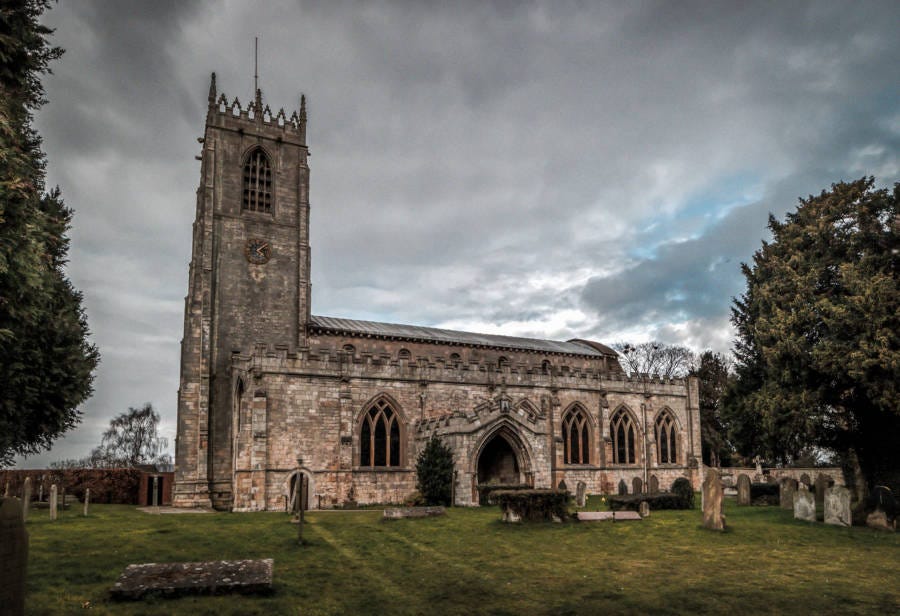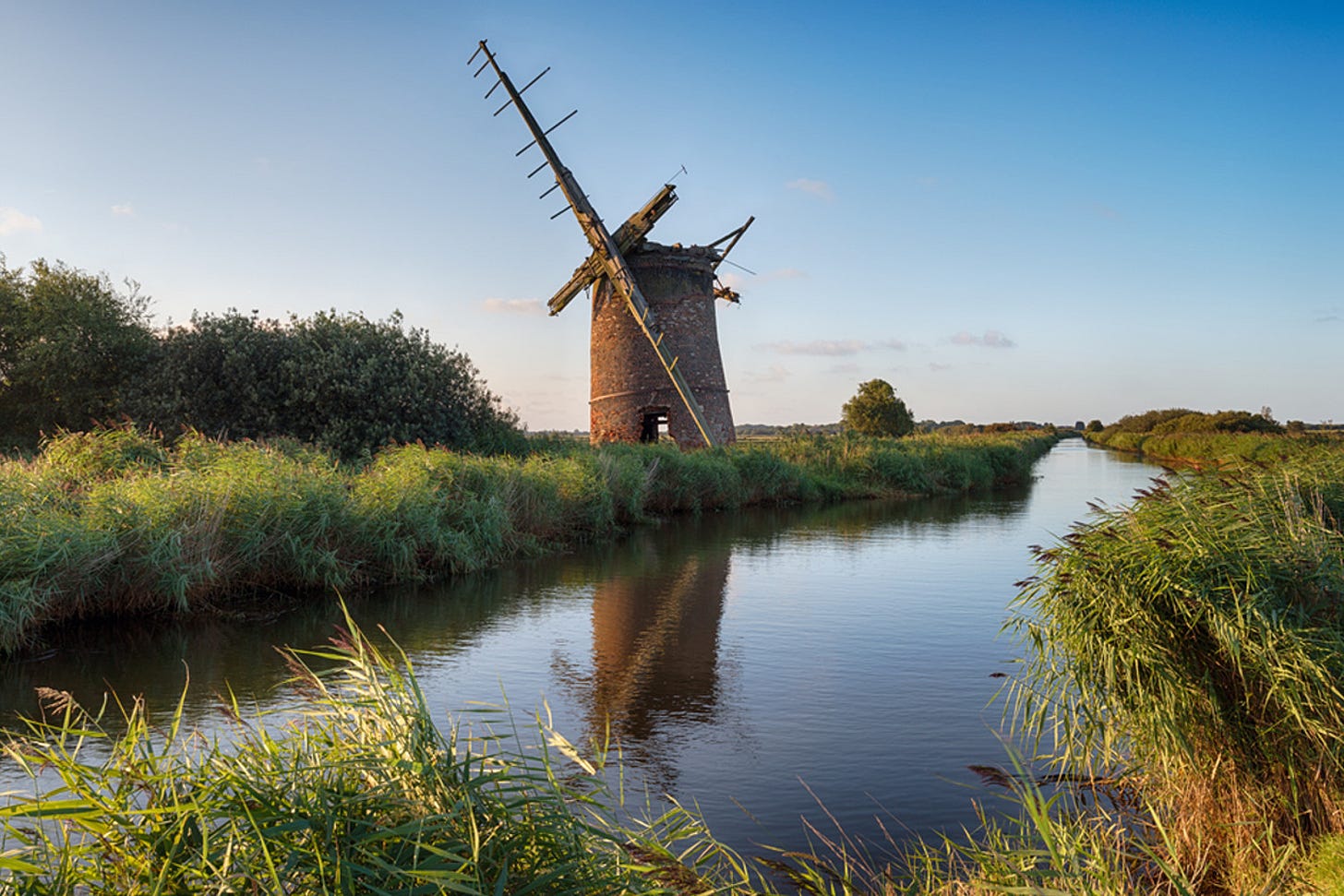Black Shuck: Hell hound of the under-realm
Evocation of the notorious demon dog of East Anglia.
Nightmares, shadows and loneliness. We of the shifting sands of post modern madness, call upon Black Shuck, hell hound of the under-realm, red burning, saucer-shaped eyes, shaggy, long coat, wide, uncanny, surreal face... the sickening stench of sulfur...
We call upon you, Black Shuck, to rise again from the depths of below ground, the chthonic realm of long eons past.
Rise, Black Shuck, rise...
Back in time. 1577AD. Holy Trinity Church, Blythburgh, in coastal Suffolk, Eastern England... a huge thunderclap ripped across the menacing skies. The great doors of the church were flung open by an enormous, terrifying hound, with red burning eyes. It charged down the nave, past the fear-struck congregation, killing two parishioners on the spot, and causing the steeple to collapse.
The very same day, at St Mary's Church in Bungay, also in Suffolk, but inland, a thunderstorm raged, lightning flashed across the furious sky... the same terrifying hell beast burst into the church, killing two of the congregation, wringing their necks as they prayed.
Glimpses of the Shuck
Gorleston, Norfolk (1972): A coastguard watched a vast black hound sprinting the sands—then it vanished in plain sight.
Wisbech, Cambs (1980s): Mother and son saw a dog the size of a calf, eyes glowing yellow, keeping pace with them before dissolving into nothing.
Aylmerton, Norfolk (1970s): A driver braked for a red-eyed hound on the lane. By the time the car reached it, the creature was gone.
Three sightings. Three impossible vanishings. Black Shuck loping just beyond the edges of reason.
At both Blythburgh and Bungay, this spectral hound left scorch marks on the doors of the churches, which can still be seen today.
As one poetic verse stated:
"All down the church in the midst of fire, the hellish monster flew, and passing onward to the quire, he many people slew."
Across the flatlands of East Anglia, this phantom devil hound stalks, his infernal gaze bringing death to most who encounter him... but not to all. For this beast, with an uncanny gait, gambols across the landscape, full of verve and vibrancy... joy even in the creation of life and death... undulating above ground and below ground as if he's swimming across the fields and meadows.
An enemy of God, for sure, for he foresaw the evil that the One God would perpetrate upon Mother Earth, how that God would defile her and ravage the very land we walk upon - and eventually send the human species into a death cult of insanity, which is where we are today. For Shuck is of the under-realm, a chthonic being, at once utterly terrifying, shaking you to the very core... a creature of growth and decay, and the sheer unknowable magnitude of nature itself.
In the flatlands of East Anglia he roams, a huge hound, the size of a small calf with blazing red eyes. He often prowls the coastal path between Sheringham and Overstrand... and around the Norfolk Broads, an area of lakes, rivers and marshes, sinkholes and fissures, and hidden meres... the hinterland of the Middle March.
He's been seen in villages such as Cantley, Blofield, Surlingham, Rockland, and in many locations along the River Yare.
In 1890, a young boy was rescued from the North Sea, telling the tale of being forced to swim further and further from the shore by a huge black dog that had chased him into the sea.
In the 1920s, there were reports from fishermen in the coastal Norfolk town of Sheringham who claimed to have heard a hound howling on the clifftops during stormy nights.
Then in 1970, a large hound was seen pounding over the beach at the seaside resort of Great Yarmouth, and the report made the headlines.
A decade later in 1980, a woman claimed to have met the hellhound while out walking her young son near Wisbech in inland Cambridgeshire. In this case the spectral hound had yellow eyes, rather than red, otherwise it matched the usual descriptions of Black Shuck.
The terrifying creature has also been sighted in the grounds of Cromer Hall on the North Norfolk coast. it's said that Sir Arthur Conan Doyle heard about the Black Shuck legends there and based his Hound of the Baskervilles story on them.
In the sprawling landscapes of Norfolk and Suffolk, mysteriously mutilated deer have been found, torn apart, by some say, this fearsome, phantom hound.
But Black Shuck is a creature of deep time, he appears in the ruptures between the comfortable (but destructive) world of modern society and the realm of the underworld.
In the insane, ravaged world we live in today, we call upon Black Shuck to roam our lands again... terrifying and monstrous perhaps, but he also has the ability to heal the corrupted and defiled landscape, both on the physical and mental plane.
It's often said, "Let sleeping dogs lie..."
I don't think so. As I stand on the long sprawling Suffolk beach with Lord Satan himself - Mr Natas - we welcome Black Shuck, and the denizens of the under-realm back into our world... to heal the terrible ravages perpetrated by the One God that led to the destruction of beast, plant, tree and flower... of the very Earth itself.
Recognize that chthonic ones are not safe... no health and safety rules, nor mRNA vaccines with them... only life and death, and the realm of the imaginal where landscape and mind become one... where the infernal hound stalks the flatlands under threatening skies and ominous clouds, past crumbling churches and old wind pumps... where the black, horse drawn carriage deposits the spectral traveler upon the marshes where he meets with the ghostly wanderers of the waste.... in the place of drowned villages, devastating floods, inland trackless fens, alder swamps... where all lonely travelers should beware for nature herself will engulf you in her sheer unending expanse, where your spirt and soul melds into the great vastness.
We call upon you, Black Shuck, to rise again from the depths of below ground, the chthonic realm of long eons past.
Rise, Black Shuck, rise...
Rise, Black Shuck, rise...
Rise, Black Shuck, rise...
Postscript
March 2021
I was parked on a quiet lane near Blofield in Norfolk, soaking in the first warmth of spring through the windscreen. Out of the corner of my eye, movement rippled across the cornfield beside me. At first, I thought it was just a dog bounding through the crops. But this was no ordinary hound.
It was the size of a small calf, its coat long and ragged, with a strange weightless gait—as if it were half-running, half-swimming through the field. Then I saw its face. Broad, uncanny, almost cartoonish—like something lifted from Alice in Wonderland. It was grinning, or so it seemed, its jaws stretched in an expression at once absurd and unsettling.
I watched it skim in and out of the furrows, flickering like an illusion. Black Shuck? A trick of the light? To this day, I cannot say.
September 2021
Months later, on a warm autumn afternoon, I was driving along Harling Drove near the village of Croxton. In the rear-view mirror, the very same creature appeared—ambling across the road with that same peculiar, elongated head and that same impossible grin.
I slowed to a crawl, half-expecting a dog owner to emerge from the hedgerows. None did. The creature was far too large for any dog I knew, and its outline carried something of the hybrid about it—part hound, part something other. It turned its head towards me, amused, even companionable.
I call it Black Shuck for want of a better name. Yet my encounters with it were not marked by dread, but by an odd sense of curiosity. Whatever it was, it seemed less a harbinger of doom than a benevolent phantom—watching, grinning, and passing on.
Further Thoughts
When I first saw the thing in March 2021, near Blofield, my mind leapt to Alice in Wonderland. That broad grin, absurd and surreal, stretched across a hound-like face. Later, leafing through De Plancy’s Dictionnaire Infernal, I realised the likeness was closer to those daemon-dogs of the Goetia — elongated mouths, grotesque yet knowing. A huge calf-sized creature with short, curly fur. Not savage. Just amused.
And it wasn’t a one-off. Months later, on Harling Drove near Croxton, I saw the same beast in the mirror. Same peculiar head, same grin. Too big for any dog. Too strange to explain. It looked at me with mischief, almost benevolence, then loped away.
I call it Black Shuck, though what it really was I cannot say.
Witness Log: Black Shook in the Modern Day
Gorleston, Norfolk — 19 April 1972: Coastguard Graham Grant saw a massive black hound on the beach, bounding freely. Then it vanished in plain sight. No tracks, no hiding place.
Great Yarmouth, Norfolk — 1970: Several reports of a huge black dog running the sands.
Wisbech, Cambs — 1980s: A woman and her young son watched a giant hound with glowing yellow eyes pace them, then dissolve into nothing.
Lowestoft, Suffolk — 1975: A woman saw Shuck in park bushes; her husband beside her saw nothing at all.
Aylmerton, Norfolk — 1970s: Driver slowed for a black dog with red eyes. It disappeared as the car reached it.
Buckhurst Hill, Essex — Summer 1989: Three teenagers panicked at the sudden appearance of a great black hound.
Norfolk marshes — undated: Father and son, out lamping, saw Shuck twice, eyeshine burning in the night.
Patterns
The same themes repeat:
Size: larger than any dog, often calf-sized.
Vanishing: dissolving in view, or slipping into nothing.
Eyes: glowing red or yellow.
Expression: not always doom—sometimes curious, even companionable.
Geography: beaches, lanes, churchyards, liminal spaces.
Witness paradox: one person sees, another beside them does not.
For me, Black Shuck was no harbinger of death. It was something older, stranger — a daimonic trickster, wearing the grin of Wonderland yet stepping out of De Plancy’s plates. Less a curse, more a shadow-guardian — glimpsed in passing, then gone.









I was 11 yrs old on a school camping trip to Hunstanton, Norfolk. The teacher waited until we’re lined up in our sleeping bags in the big old tent, already mildly traumatised from leaving our homes for the first time, the bastard told us about the beast. Three of us spent the night weeping. I always thought he was called Black Shep, my frightened scarred brain perhaps blocking out the unnameable... the story has often put the fear into my kids too. Thanks for the research and revival...